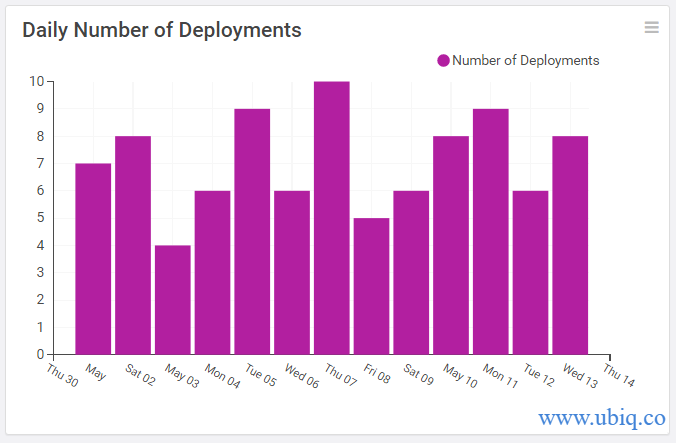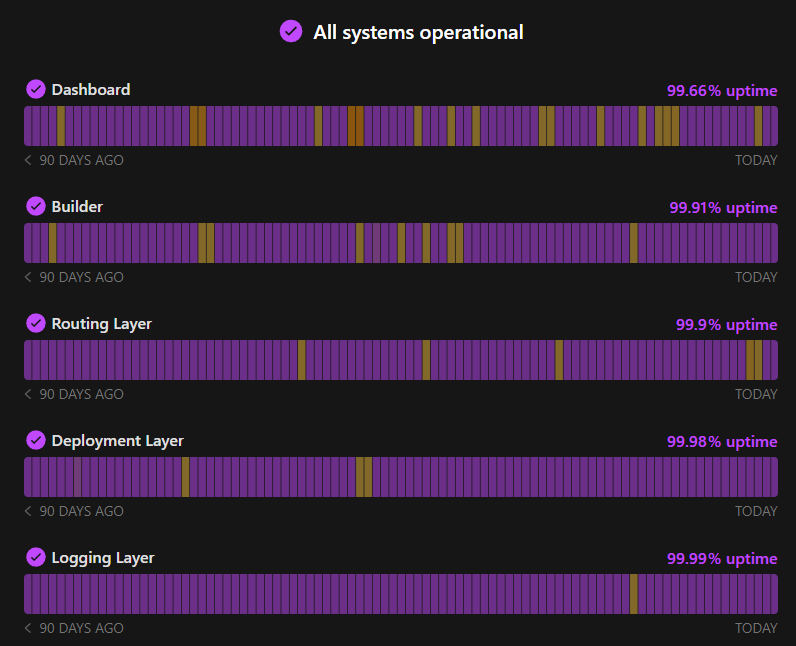Deployment Frequency: A Key Metric in DevOps

DevOps doesn’t fully work without monitoring metrics. And software development doesn’t work if you don’t deploy code. Together, these two things combine into the key deployment frequency metric. You can better understand your team's performance by quantifying and tracking a metric like deployment frequency. Is your team deploying efficiently? Are the principles of DevOps being achieved with your team’s deployment schedule?
Using deployment frequency will create a conversation around frequency and quality among your developers. While your team finds the balance between the two, prepare for the inevitable outages and hotfixes. With Instatus, you can create simple yet beautiful status pages to brief your users on any outages that may occur when increasing the deployment frequency.
What is Deployment Frequency (DF)?
Your team’s deployment frequency is the frequency that code is deployed. This metric is a DORA metric. Typically when calculating deployment frequency, you count all deployments, even those that resulted in outages, rollbacks, hotfixes, or service interruptions. You can easily track this metric and should start tracking it today if you’re not.
DevOps methodology is all about continuous integration and continuous deployment. Read that again. Continuous deployment is vital to the DevOps pipeline. Deployment frequency is often the first time a development team may start making changes to improve.
It seems simple right? Just throw in a few more deployments a week, and boom, your frequency has risen significantly. But it’s not that simple. High-performing teams deliver code for production and launch every day. Large successful tech companies, like FAANG, hit this mark every day. Their budgets are enormous, and they have whole teams of developers working on all sorts of projects. Small organizations face many more challenges in meeting the ultimate goal in Deployment Frequency, delivering small daily high-quality deployments.
How to Measure Deployment Frequency?
Calculating Deployment Frequency is easy if your team uses version control like Jira or GitHub or CI/CD tools like Jenkins. Simply extract the number of builds for your software over a period of time. Your organization can decide if it wants to count all deployments or only ‘successful’ deployments. Any deployment that requires remediation or results in degraded service for users counts as a change failure, which is part of another key DORA metric.

To calculate Deployment Frequency (DF):
# of change deployments / time = Deployments per unit of time
OR
# of successful deployments / total deployments = Deployment frequency %
How is your Team performing?
Measure deployment frequency and then compare with the following standards to find out how your team is performing in this area:
- Low Performing – One month to six months between deployments
- Medium Performing – One week to one month between deployments
- High Performing – One day to one week between deployments
- Elite Performing – Multiple deployments per day/ less than one day between deployments
If your team’s deployment frequency is, on average, under a week, then you are among the highest-performing development teams. It’s essential to consider where in your software’s lifecycle you are when considering deployment frequency performance.
It’s common to release frequent smaller deployments between large feature updates or versions. Deployment frequency may drop in the weeks preceding a more significant update, as developers are busy with other things. But being able to effectively pivot and push out daily deployments for bug fixes, small changes, and more is vital during the in-between times.

Improve Deployment Frequency
Deployment frequency is a tricky metric when discussing its interactions in the bigger DevOps picture. If your team takes the wrong approach with deploying to production, it can lead to the degradation of other DORA metrics. Alternatively, if your team gets it right, then increasing deployment frequency will yield better results in the three other DORA metrics:
- Change Failure Rate
- Mean Time to Recovery
- Lead Time for Changes
Getting it Wrong
Don’t cut corners in the development process just to push changes down the pipeline as fast as possible. Short cuts will only hurt the team in the long run. Even worse, a stream of bad deployments can harm your reputation with your users. Keep all current processes in place, including code review and automated testing.
Stay away from promoting competition within the team dynamic. You shouldn’t apply individual metrics to team members. Instead, you want the entire team to focus on working together towards the team performance metrics.
When you get it wrong, your change failure rate (CFR) will increase and your mean time to recovery (MTTR) may also take a hit. Your lead time for changes usually drops as deployment frequency increases.
Getting it Right
Identify areas of improvement within each stage of development. Continuous integration and development mean the entire process needs to move efficiently, or you will have bottlenecks. Bottlenecks are where all your deployments go to die.
- Reduce Chunk Size
When a change is first proposed, consult the entire team to see how it may be broken down into smaller components. Developers work most efficiently if they spend their entire time on a single project or issue. Once developers start playing the balancing game, dividing up their day across releases, the team is shifting in a bad direction.
Reducing your chunk size is an iterative process. If your team is more familiar with larger releases, it takes time to break that pattern. With a smaller chunk size, developers get feedback more often and can resolve an issue immediately.
- Continuous Positive Feedback
By reducing chunk size, your team is working with changes from conception to completion frequently. This creates a positive feedback loop. The process becomes second nature as team members become more familiar with the code review, testing, and automated deployment steps.
- Continuous Integration
Once features are written, and code review is done, immediately integrate them into your main code base. Pushing changes to the central repository as quickly as possible, reduces the chance of integration conflicts later on.
Waiting until all team members are completed with their sprint project and then integrating may mean going back to solve integration issues. This is inefficient and wastes time. Ultimately, the number of deployments you can push to production is reduced by poor integration.
- Automated Testing
Automated testing is your friend. Automation keeps your developers from wasting time on repetitive tasks. Instead, your developers can work on tasks that require greater creativity and ingenuity than testing. Once developers integrate their code changes, automated testing takes over.

- Automated Deployment
Take human error out of deploying to production by automating the process. Changes that have passed through automated testing are automatically rolled out without any action taken by the development team. Automated deployment mostly breaks down to scripts that handle the deployment processes, such as:
- Prepare the production environment for the update
- Deploy the code packages
- Database migration or other deployment tasks
- Adjust configuration for deployment
- Post-deployment testing scripts to check that services are accessible and verify deployment was successful
A major part of automated deployment is automated monitoring and alert systems if something goes wrong. Instatus will automatically detect any systems or service drops. When users access your status page, they can see if there are any current issues. Otherwise, use are greeted with an All systems operational message.
Wrapping up Deployment Frequency
Deployment frequency is a performance metric measuring the number of deployments a team is pushing to production over a given time. Are deployments happening on a daily, weekly, or monthly frequency? Infrequent deployments indicate your team is not agile or efficient, and you may have some process bottlenecks that need attention.
Elite development teams can push dozens of small deployments a day. Increasing deployment frequency comes down to reducing your batch sizes, getting more familiar with the deployment process, continuous integration, automated testing, and automated deployment. Remember to keep your users updated on issues associated with deployments. Let Instatus handle all the services monitoring for you, and your users will enjoy the beautiful and informational status pages.
Get ready for downtime
Monitor your services
Fix incidents with your team
Share your status with customers


